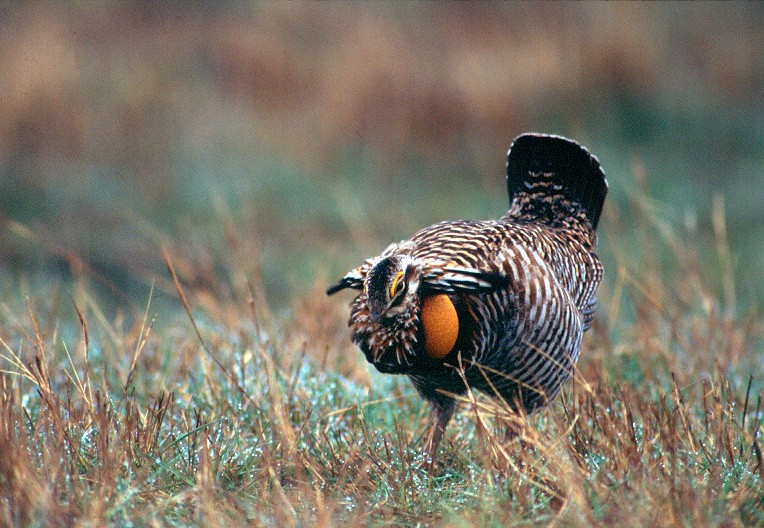Greater Prairie-chicken
A species of Prairie-chickens, Also known as Pinnated Grous Scientific name : Tympanuchus cupido Genus : Prairie-chickens
Greater Prairie-chicken, A species of Prairie-chickens
Also known as:
Pinnated Grous
Botanical name: Tympanuchus cupido
Genus: Prairie-chickens
Content
Description General Info
 Photo By South Dakota Department of Tourism , used under Attribution /Cropped and compressed from original
Photo By South Dakota Department of Tourism , used under Attribution /Cropped and compressed from original Description
Adults of both sexes are medium to large chicken-like birds, stocky with round-wings. They have short tails which are typically rounded. Adult males have orange comb-like feathers over their eyes and dark, elongated head feathers that can be raised or lain along neck. They also possess a circular, un-feathered neck patch which can be inflated while displaying; this, like their comb feathers, is also orange. As with many other bird species, the adult females have shorter head feathers and also lack the male's yellow comb and orange neck patch. Adults are about 16.9 in (43 cm) long, and weigh between 24.7–42.3 oz (700–1200 g). The greater prairie-chicken has a wingspan range of 27.4-28.5 in (69.5-72.5 cm). 
Size
43-46 cm (17-18 in)
Life Expectancy
1.6 years
Nest Placement
Ground
Clutch Size
5 - 17 eggs
Incubation Period
1 brood
Number of Broods
23 - 25 days
Feeding Habits
Greater Prairie-chicken's diet consists primarily of seeds, leaves, buds, fruits, acorns, and cultivated grains such as corn, sunflower, soy, and sorghum. They frequently consume insects, including grasshoppers, crickets, and beetles. Foraging occurs mostly on the ground, but they may climb trees for buds and leaves, particularly when snow covers ground resources. Chicks predominantly eat insects.
Habitat
Greater Prairie-chicken's preferred habitat encompasses native mixed-grass and tallgrass prairies with interspersed croplands and sparse trees. These birds require diverse environments, which include patches of oak woodland and savannahs essential for their communal mating displays on open lands. Dense brush serves as a crucial nesting refuge, while open insect-rich areas benefit foraging hens and chicks. Winter habitats resemble their general prairies but feature proximity to croplands and brushy roosting spots.
Nest Behavior
Greater Prairie-chicken females select the nesting site and craft the nest, where they lay eggs. The timing, egg-laying patterns, and parental care specifics remain undocumented in the provided information.
Nest Characteristics
Greater Prairie-chicken typically makes a bowl-shaped depression in grasslands with brushy cover, with surrounding vegetation ranging from 10 to 28 inches high. The nest is lined with feathers, dried grass, leaves, and twigs, measuring approximately 7 inches wide and 2.8 inches deep.
Dite type
Granivorous
General Info
Feeding Habits
Bird food type
Behavior
Greater Prairie-chicken navigate their environment with a slow, deliberate walk, often foraging for seeds and grains on the ground, but will venture into trees for buds and fruits. They possess the strength for extended flights, commonly traveling miles to alternate between roosting and feeding locations. Characteristic of their unique behaviors is the ritualistic lek mating system. Here, males engage in a visually and auditorily striking 'booming' dance: posturing with vivid neck tufts and eye combs, feet stamping, and inflating bright orange neck sacs to vocalize their presence. Territorial displays can escalate to physical confrontations or be solved through ritualized standoffs. Female greater Prairie-chicken, with their own subset of behaviors, selectively mate with the most prominent males. Post-breeding, greater Prairie-chicken form flocks as the seasons change.
Species Status
The greater prairie chicken was almost extinct in the 1930s due to hunting pressure and habitat loss. In Illinois alone, in the 1800s the prairie chicken numbered in the millions. They were a popular game bird, and like many prairie birds, which have also suffered massive habitat loss, they are now on the verge of extinction, with the wild bird population at around 200 in Illinois in 2019. They now only live on small parcels of managed prairie land. Throughout North America, it is thought that their current population has declined severely, to approximately 500,000 individuals. In May 2000, the Canadian Species at Risk Act listed the greater prairie chicken as extirpated in its Canadian range (Alberta, Saskatchewan, Manitoba, Ontario). It was again confirmed by the Committee on the Status of Endangered Wildlife in Canada in November 2009. Nonetheless, sightings and encounters continue to occur in the south-central regions of Alberta and Saskatchewan, along with southern Ontario, where sightings are extremely rare. In states such as Iowa and Missouri that once had thriving prairie chicken populations (estimated to be hundreds of thousands), total numbers have dropped to about 500. However, the Missouri Department of Conservation has started a program to import prairie chickens from Kansas and Nebraska in the hopes that they will be able to repopulate the state and increase that number to 3,000. Central Wisconsin is home to approximately 600 individuals, down from 55,000 when hunting was prohibited in 1954. Though this area was predominately spruce and tamarack marsh before European settlement, early pioneers drained the marshes and attempted to farm the poor soil. As the prairies to the south and west were lost to agriculture and development, and the southern half of Wisconsin was logged, the prairies spread northward into the abandoned farmland. Today, over 30,000 acres are managed by the Wisconsin Department of Natural Resources as greater prairie chicken habitat. Birdwatchers travel from around the world to visit Wisconsin in April for the Central Wisconsin Prairie Chicken Festival, started in 2006 by Golden Sands Resource Conservation & Development Council, Inc. 

 Photo By South Dakota Department of Tourism , used under Attribution /Cropped and compressed from original
Photo By South Dakota Department of Tourism , used under Attribution /Cropped and compressed from original Scientific Classification
Phylum
Chordates Class
Birds Family
Phasianidae Genus
Prairie-chickens Species
Greater Prairie-chicken